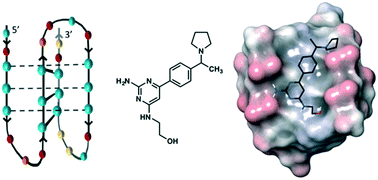Themed collection Molecular Pharmacology

Emerging modes-of-action in drug discovery
An increasing focus on complex biology to cure diseases rather than merely treat symptoms is transforming how drug discovery can be approached, and expands the arsenal of drug modalities and modes-of-actions that can be leveraged to modify diseases.

Med. Chem. Commun., 2019,10, 1550-1568
https://doi.org/10.1039/C9MD00263D
Synthetic small-molecule RNA ligands: future prospects as therapeutic agents
RNA is one of the most intriguing and promising biological targets for the discovery of innovative drugs in many pathologies and various biologically relevant RNAs that could serve as drug targets have already been identified.

Med. Chem. Commun., 2019,10, 1242-1255
https://doi.org/10.1039/C9MD00195F
Studies on spiro[4.5]decanone prolyl hydroxylase domain inhibitors
Structure–activity relationship and crystallographic studies on HIF prolyl hydroxylase inhibitors reveal spiro[4.5]decanones as useful templates for generation of potent and selective 2OG oxygenase inhibitors.
![Graphical abstract: Studies on spiro[4.5]decanone prolyl hydroxylase domain inhibitors](/ja/Image/Get?imageInfo.ImageType=GA&imageInfo.ImageIdentifier.ManuscriptID=C8MD00548F&imageInfo.ImageIdentifier.Year=2019)
Med. Chem. Commun., 2019,10, 500-504
https://doi.org/10.1039/C8MD00548F
Progress toward allosteric ligands of metabotropic glutamate 7 (mGlu7) receptor: 2008–present
Metabotropic glutamate type 7 (mGlu7) receptor is a member of the group III family of mGlu receptors.

Med. Chem. Commun., 2019,10, 193-199
https://doi.org/10.1039/C8MD00524A
Link between a high kon for drug binding and a fast clinical action: to be or not to be?
Simulations show under which conditions increasing a drug’s kon can bring about faster clinical action.

Med. Chem. Commun., 2018,9, 1426-1438
https://doi.org/10.1039/C8MD00296G
Photophysical properties and application in live cell imaging of B,B-fluoro-perfluoroalkyl BODIPYs
B,B-Fluoro-perfluoroalkyl BODIPYs 2 (R = CF3) and 3 (R = C2F5) exhibited higher photo- and chemical stability than B,B-difluoro-BODIPY 1.

Med. Chem. Commun., 2019,10, 1121-1125
https://doi.org/10.1039/C9MD00011A
A MedChem toolbox for cereblon-directed PROTACs
A modular chemistry toolbox was developed for cereblon-directed PROTACs.

Med. Chem. Commun., 2019,10, 1037-1041
https://doi.org/10.1039/C9MD00185A
Fluoroquinolone-derived fluorescent probes for studies of bacterial penetration and efflux
Fluorescent probes derived from the fluoroquinolone antibiotic ciprofloxacin were synthesised using a Cu(I)-catalysed azide–alkyne cycloaddition (CuAAC) to link a ciprofloxacin azide derivative with alkyne-substituted green and blue fluorophores.

Med. Chem. Commun., 2019,10, 901-906
https://doi.org/10.1039/C9MD00124G
Anthranilic amide and imidazobenzothiadiazole compounds disrupt Mycobacterium tuberculosis membrane potential
Compounds 1 and 2 disrupt M. tuberculosis membrane potential and demonstrate bactericidal activity against non-replicating M. tuberculosis in pH 4.5 buffer.

Med. Chem. Commun., 2019,10, 934-945
https://doi.org/10.1039/C9MD00088G
Controlling cellular distribution of drugs with permeability modifying moieties
Anionic moieties can be used to control the cell-permeability of drugs and used to select the appropriate target identification method for phenotypic screening hits.

Med. Chem. Commun., 2019,10, 974-984
https://doi.org/10.1039/C8MD00412A
Mechanism of thienopyridone and iminothienopyridinedione inhibition of protein phosphatases
Thienopyridone and iminothienopyridinedione inhibit protein phosphatases through a redox mechanism to oxidise the active site cysteine.

Med. Chem. Commun., 2019,10, 791-799
https://doi.org/10.1039/C9MD00175A
4′-Phosphopantetheine and long acyl chain-dependent interactions are integral to human mitochondrial acyl carrier protein function
Insights into the role of 4′-PP- and long acyl chains-dependent interactions in human ACPM function.

Med. Chem. Commun., 2019,10, 209-220
https://doi.org/10.1039/C8MD00489G
Design and characterization of a heterocyclic electrophilic fragment library for the discovery of cysteine-targeted covalent inhibitors
A fragment library of electrophilic small heterocycles was characterized through cysteine-reactivity and aqueous stability tests that suggested their potential as covalent warheads.

Med. Chem. Commun., 2019,10, 263-267
https://doi.org/10.1039/C8MD00327K
Vinyl sulfonamide synthesis for irreversible tethering via a novel α-selenoether protection strategy
A novel strategy for the synthesis of vinyl sulfonamide fragments for application to irreversible protein tethering.

Med. Chem. Commun., 2019,10, 158-163
https://doi.org/10.1039/C8MD00566D
Exploring the effectiveness of novel benzimidazoles as CB2 ligands: synthesis, biological evaluation, molecular docking studies and ADMET prediction
Herein we continued our previous work on the development of CB2 ligands, reporting the design and synthesis of a series of benzimidazole-containing derivatives that were explored as selective CB2 ligands.

Med. Chem. Commun., 2018,9, 2045-2054
https://doi.org/10.1039/C8MD00461G
Probing the hras-1Y i-motif with small molecules
Identification of HRAS i-motif-binding small molecules.

Med. Chem. Commun., 2018,9, 2000-2007
https://doi.org/10.1039/C8MD00311D
Structure activity relationship of 2-arylalkynyl-adenine derivatives as human A3 adenosine receptor antagonists
Adenines that incorporate known agonist affinity-enhancing substituents are A3AR-selective antagonists.

Med. Chem. Commun., 2018,9, 1920-1932
https://doi.org/10.1039/C8MD00317C
Novel tricyclic glycal-based TRIB1 inducers that reprogram LDL metabolism in hepatic cells
Increased expression of the Tribbles pseudokinase 1 gene (TRIB1) is associated with lower plasma levels of LDL cholesterol and triglycerides, higher levels of HDL cholesterol and decreased risk of coronary artery disease.

Med. Chem. Commun., 2018,9, 1831-1842
https://doi.org/10.1039/C8MD00297E
Development of a [68Ga]-ghrelin analogue for PET imaging of the ghrelin receptor (GHS-R1a)
A 68Ga-labelled ghrelin(1-19) analogue is described as a high affinity peptide for ghrelin receptor PET imaging using a sequence derived directly from the endogenous ligand, yet modified for improved stability.
![Graphical abstract: Development of a [68Ga]-ghrelin analogue for PET imaging of the ghrelin receptor (GHS-R1a)](/ja/Image/Get?imageInfo.ImageType=GA&imageInfo.ImageIdentifier.ManuscriptID=C8MD00210J&imageInfo.ImageIdentifier.Year=2018)
Med. Chem. Commun., 2018,9, 1761-1767
https://doi.org/10.1039/C8MD00210J
A zwitterionic near-infrared dye linked TrkC targeting agent for imaging metastatic breast cancer
A probe that conjugated a TrkC targeting agent with a zwitterionic near-infrared dye was reported for imaging of metastatic breast cancer.

Med. Chem. Commun., 2018,9, 1754-1760
https://doi.org/10.1039/C8MD00190A